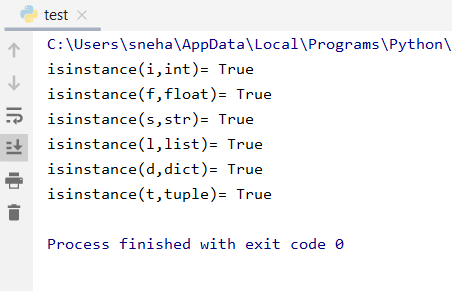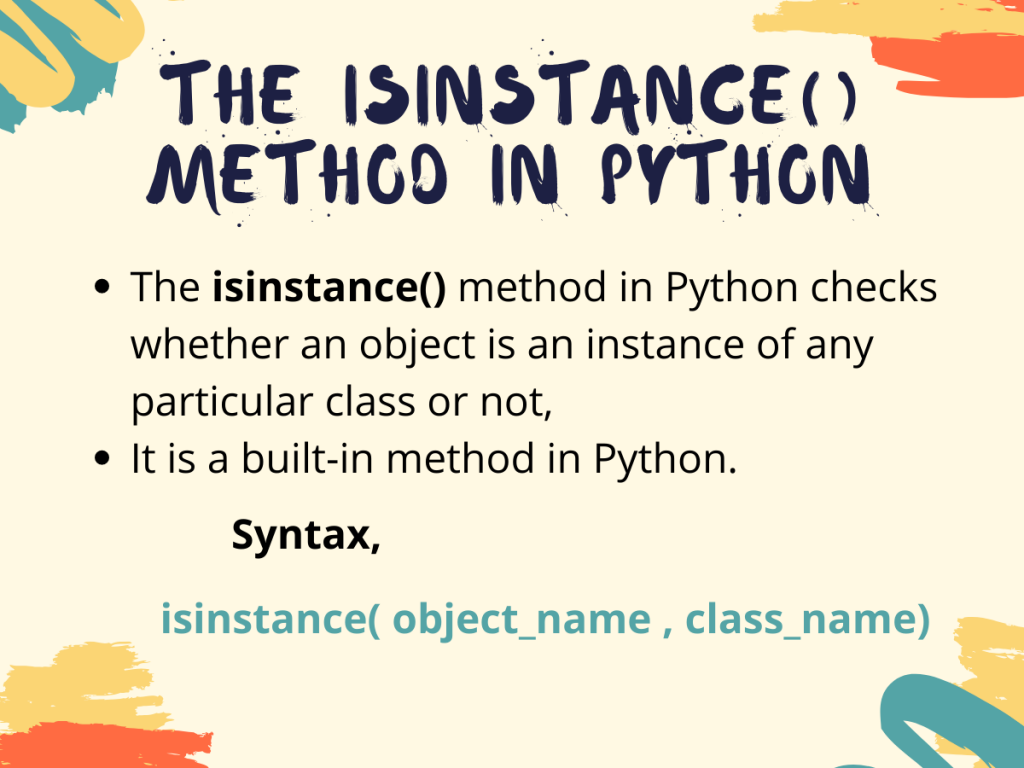Introduction
In this tutorial, we’ll go over the Python isinstance() method. A user may encounter some situations where she/he needs to determine whether an object is an instance of a specific class, mainly in inheritance. Python provides an in-built method do check the same, named isinstance().
Let’s get right into understanding this method.
Python isinstance() basics
As the name suggests, the Python isinstance() method is an in-built method which checks whether an object is an instance of any particular class or not. Now, let us look at the syntax for using the isinstance() method,
Syntax,
isinstance( object_name , class_name)
Here,
object_nameis the object for which we need to check whether it is an instance of some class or not,class_nameis the class to which we need to check the object belongs to or not,- the
isinstance()method returns true if the object_name is an instance of the class class_name or else returns false.
Examples of Python isinstance()
So, since now we are done with the basic definition and syntax for the Python isinstance() method. Let us look at some examples for better understanding of how the method works.
1. Using isinstance() with native classes in Python
Now, let us see what happens when we use the isinstance() method for native classes in python like int, float, str, list, dict, and tuple.
i=10
f=55.55
s="AskPython"
l=[1,2,3,4,5]
d={0:"n", 1:"y"}
t=(1,2,3,4)
print("isinstance(i,int)=",isinstance(i,int))
print("isinstance(f,int)=",isinstance(f,float))
print("isinstance(s,int)=",isinstance(s,str))
print("isinstance(l,int)=",isinstance(l,list))
print("isinstance(d,int)=",isinstance(d,dict))
print("isinstance(t,int)=",isinstance(t,tuple))
Output:

Let’s understand what’s happening here:
- At first, we have initialized variables of different types with some values
- After that, we check whether they are instances of the corresponding classes or not. And as expected for all the checkings we get positive outputs, that is, true.
2. Using isinstance() with user-defined classes
Now let us create some classes and their instances to check whether we get our desired output as well as how the isinstance method works in that case.
class dt:
dd=10
mm=2
yyyy=2002
class tm:
hr=12
min=56
sec=34
#instance creation
a=dt()
b=tm()
#check is a is instance of dt class
print("a is instance of dt?",isinstance(a,dt))
#check is a is instance of tm class
print("a is instance of tm?",isinstance(a,tm))
#check is b is instance of tm class
print("b is instance of tm?",isinstance(b,tm))
#check is b is instance of dt class
print("b is instance of dt?",isinstance(b,dt))
Output:

In this code:
- We create two classes
dtandtmsymbolizing date and time respectively - After that is done, we create two objects of both the classes named a and b respectively
- Then we check whether the objects a and b are instances of the
dtandtmclasses. Using different combinations we try to explain what happens if the object is not an instance of the specified class - As we can see, our code confirms that a and b are instances of classes dt and tm respectively.
- But the method
instance()returns false when we try to check whether a and b are instances of tm and dt classes respectively. That is, opposite.
3. Using isinstance() for multiple classes
The Python isinstance() method also provides a measure if we want to check whether an object is an instance of any class among some given classes.
In that case, we need to pass a tuple of the required classes. The method will return true if the object is an instance of any class, or else returns false.
class dt:
dd=10
mm=2
yyyy=2002
class tm:
hr=12
min=56
sec=34
#instance creation
a=dt()
b=tm()
#check is a is instance of dt or tm class
print("a is instance of dt or tm?",isinstance(a,(dt,tm)))
#check is b is instance of dt or tm class
print("b is instance of dt or tm?",isinstance(b,(dt,tm)))
Output:
a is instance of dt or tm? True
b is instance of dt or tm? True
Here, we use the same classes dt and tm as we used in our previous example. But in this case, we pass a tuple of the two classes to the isinstance() method.
Since a and b are instances of any one of the classes in the tuple we passed, we get to see true in both the outputs.
Conclusion
So, in this tutorial, we got to learn about the Python isinstance() method along with its uses and working. Hope this tutorial helps in understanding the concept of instances.
References
- https://www.journaldev.com/22932/python-isinstance
